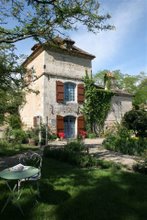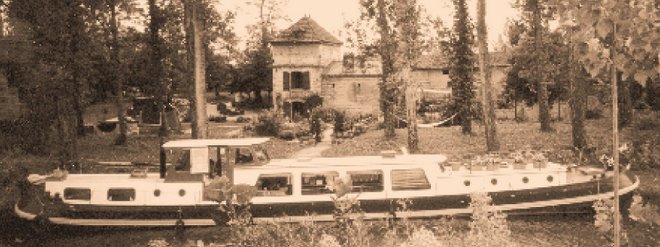 This Saturday table is typical- too much food bought by hungry eyes at the weekly market at Nerac. Tricia Robinson (Taste of Provence) trains over from Nice for a Gascon weekend and we celebrate the first fall oysters, cheese from Salers, a jambon glacee, pate de canard, ripe figs, a decent loaf of bread. What a good life! Saturday chores were never like this.
This Saturday table is typical- too much food bought by hungry eyes at the weekly market at Nerac. Tricia Robinson (Taste of Provence) trains over from Nice for a Gascon weekend and we celebrate the first fall oysters, cheese from Salers, a jambon glacee, pate de canard, ripe figs, a decent loaf of bread. What a good life! Saturday chores were never like this.
September 20, 2005
Retour de la Marche'
 This Saturday table is typical- too much food bought by hungry eyes at the weekly market at Nerac. Tricia Robinson (Taste of Provence) trains over from Nice for a Gascon weekend and we celebrate the first fall oysters, cheese from Salers, a jambon glacee, pate de canard, ripe figs, a decent loaf of bread. What a good life! Saturday chores were never like this.
This Saturday table is typical- too much food bought by hungry eyes at the weekly market at Nerac. Tricia Robinson (Taste of Provence) trains over from Nice for a Gascon weekend and we celebrate the first fall oysters, cheese from Salers, a jambon glacee, pate de canard, ripe figs, a decent loaf of bread. What a good life! Saturday chores were never like this.
September 12, 2005
Gascon Alarm clocks- 'coin, coin'

A series of taps on the steel side of this old boat. The morning alarm clock on the Julia Hoyt floats by in the guise of a flotilla of ducks cleaning the moss off of the hull. September waits for no lazy bones and there is much to do here at Camont in Southwest France: mushrooms to gather, grapes to harvest and the last and sweetest tomatoes to gather in from the potager. All of Gascony buzzes around me, a hive of harvest activity this month in my Long Village.
I walk Dupont along the driveway wide road that leads to Camont and hail my neighbor working in his potager.
‘Bon Jour! Vous avez encore des haricots verts?’
‘Beh, oui et plus!’
My fast walk turns into a weight lifting session as I struggle home under a fruit box full of a lettuce, two giant beets, three eggplants, a red pepper and hand handful of fennel flower full of the fragrant Pollen that la Diva in Tuscany calls Magic. Oh… and a couple kilos of haricots verts.
It is easy to cook here in Gascony. Easy to celebrate our ‘daily bread’ and inspire a new generation to cook, really cook with what's at hand. Good food in the French kitchen.
September 03, 2005
Grassroots movements a foot

Pilgrims on foot to Santiago de Compostello in western Spain stretch across many roads and paths here in southwest France. These are their last steps across gentle hills before arriving at the Pyrenees passes and the long stretch of one well-trodden route to the holy field of stars. I have longed planned to join their blistered ranks but the sacred daily living in my home sweet Gascon home keeps me focused on closer goals.
Just thirty minutes away from the French Kitchen a holy pilgrim site tumbles down an ancient river valley escarpment to a cluster of former fishermen houses called le port. This split-level village of Auvillar on the banks of the Garonne straddles the GR65 (Grande Randonnée soixante-cinq). Marked with the familiar red and white stripes, the walking trail follows medieval roads and tracks southwest across France—le chemin de St. Jacques de Compostelle. Auvillar, one of the plus beaux villages de France, is indeed a lovely stop along the long trail. In the upper village or alta villa, a coin-shaped grain hall shelters a modest Sunday morning market. Careful brick architecture arcades around the market place as artists, antique shops, a modern calligrapher, a very good restaurant and several cafés, a pottery and a bargees museum crowd the panoramic site. I often come to eat Serge Francois’ very good cooking at L’Horloge, but find myself spending more and more time at the bottom of the very steep road that leads from le port.
It’s been more than a century since the Garonne was navigable here, but the memory of an active fishing fleet and cargo port lingers: A house perched just steps from the shallow banks of the Garonne is called La Crue, the Flood; A newly restored building housing the Virginia Center for the Creative Arts retreat studios is called the Moulin a Nef in honor of the floating mill once anchored in mid-river; and just next door is the object of my particular affection—a tumble of flat Roman bricks supporting a solitary bell, The Chapel of St. Catherine du Port.
Beginning with just one piece of fruit, Priscilla Randall intuitively lives up to her initials and has generated a public relations plan sweet enough to eat. An American friend and renowned landscape architect, Priscilla lives across from the sad little chapel. She invited me to lunch one day to discuss her summer plan for helping save the 14th-century frescos now hidden in the decaying brick building. Too unsafe to enter, she shows me photocopies of the faint frescoes, early heraldry of the village, and a cross and anchor insignia in a rose window. If ever I could adopt a cause, it was this one! A riverside church for ancient bargemen named after my patron saint!
As crafty as a Yankee Tom Sawyer, Priscilla enlisted my help I think as as much to white-wash my soul as to paint the holy fence. Over a glass of delicious melon soup she had made from cookbook, P.R. managed to enlist me in helping launch a grassroots campaign to focus attention on the frescoed chapel’s deplorable state. She took me out back to show me her opening gambit. A makeshift fruit stand, offering a delicious tongue in cheek pèche effacente pêche—‘sin erasing peaches’. As close to selling indulgences as she could get. Each perfect juicy height-of-the-summer season pale pink peach was 65 centimes- a bargain for the dozens of weary pilgrims stopping to admire the history of the way as they stayed at the nearby gite d’etape. A modest contribution to their soul saving as well as to new roof tiles.
By nature, grassroots movements are slow but invasive. Priscilla’s personal efforts to engage the pilgrims in contributing, no matter how small the cost, has now led us to dedicate November 25th, St. Catherine of Alexandria’s feast day and the traditional time to plant fruit trees in France. I volunteer to cook a fundraising lunch when we a plant a tree to launch the serious "Several Thousand Euro Project" to restore the 10th-century building and it’s frescoes. From one peach to a one-hundred-Euro-a-plate lunch to the necessary paperwork and French grants is as simple a plan as putting one foot in front of the other to walk a thousand miles.
Subscribe to:
Posts (Atom)






